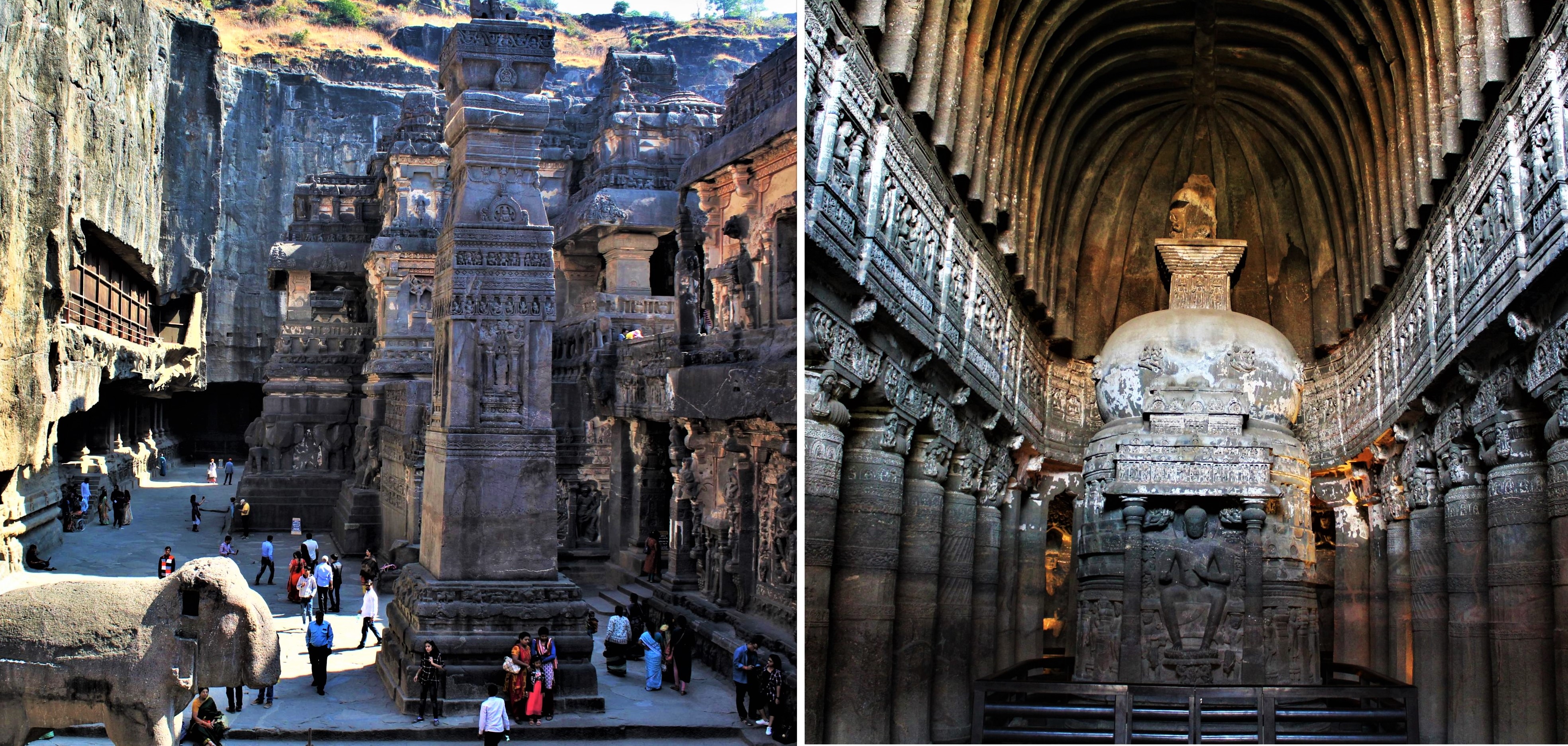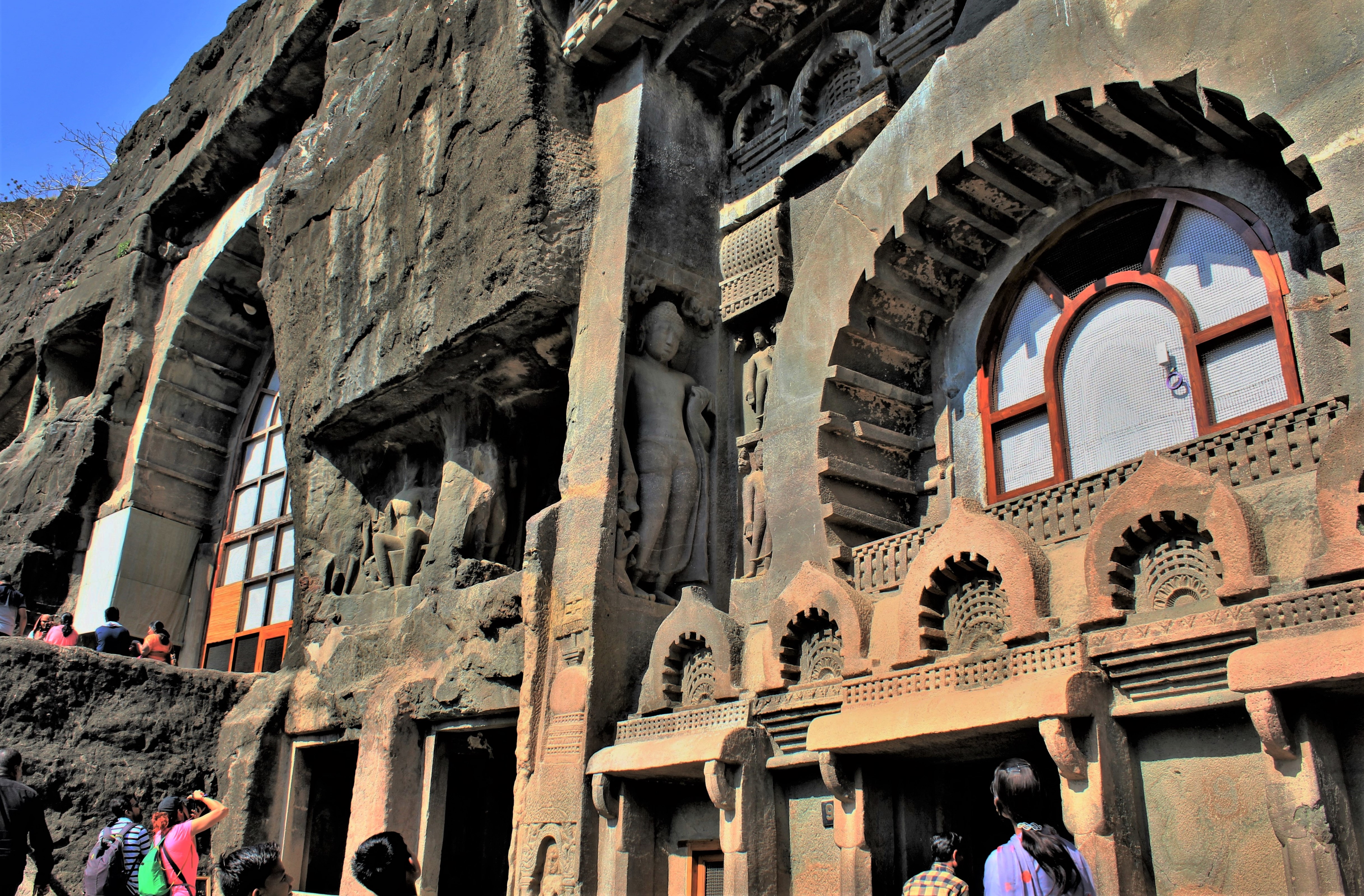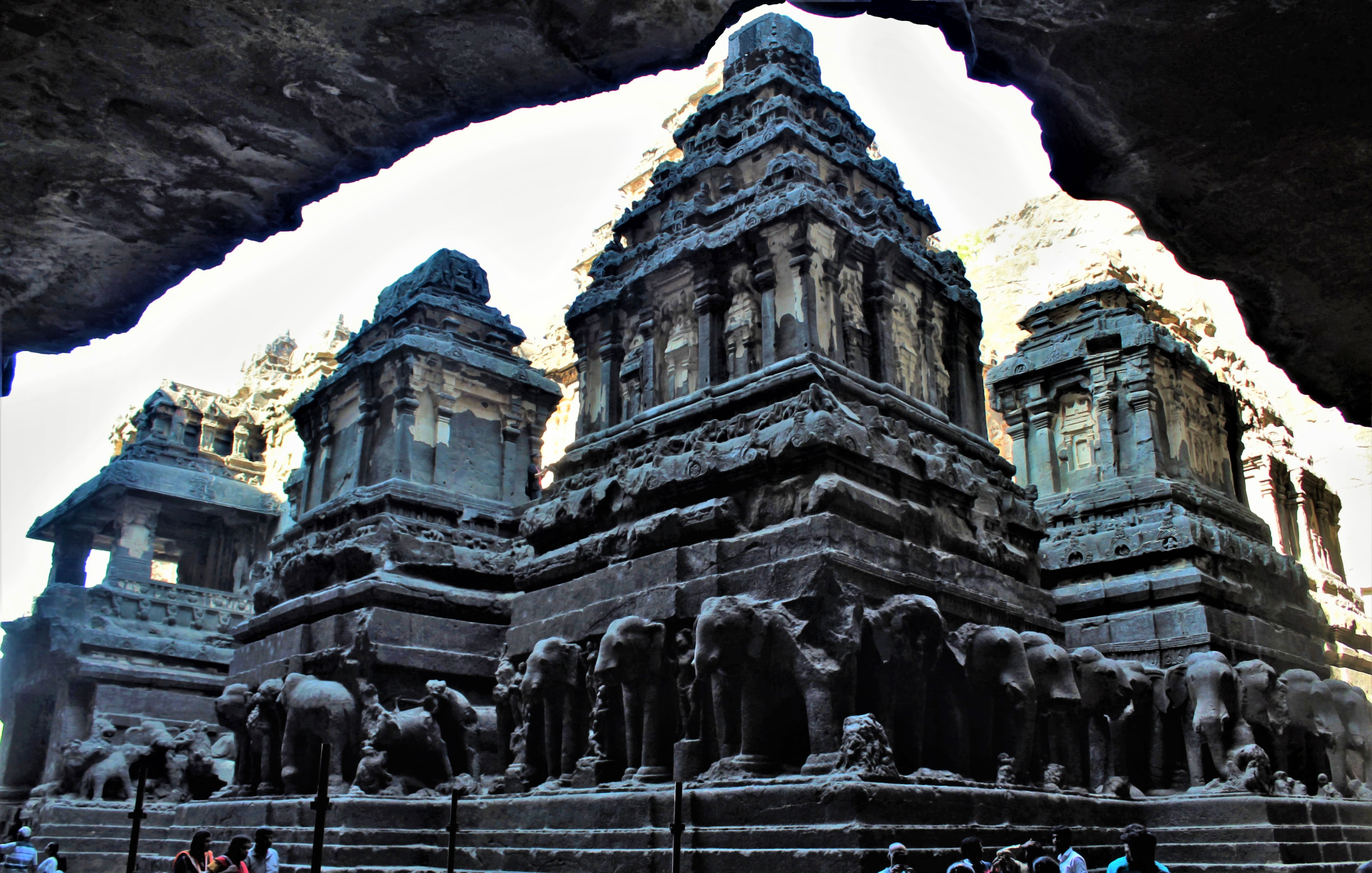Reading Time: 9 mins

The Ancient Caves of India are probably the best representatives of India’s glorious past. There are a multitude of caves in India spread all over the country. While some of these are natural wonders, some are man-made archaeological wonders. Carved centuries ago, these rock-cut caves offer a mix of history, culture, art, adventure and spirituality. These ancient and medieval structures do not only thrill us with their spectacular art-work but also astonish us with the level of structural engineering involved while carving them out of huge solid natural rocks (Rock-cut Architecture).
Some of these have become world famous, whereas some have remained grossly unexplored and you may not have even heard of them. Then which are the ones you should visit? Here is a list of caves and cave temples in India that are worth visiting at least once in your lifetime:
- Ajanta & Ellora, Elephanta Caves, Karla Caves (Maharashtra)
- Borra Caves, Undavalli Caves (Andhra Pradesh)
- Bhimbetka Rock Shelters (Madhya Pradesh)
- Amarnath, Vaishno Devi (Jammu and Kashmir)
- Udayagiri & Khandagiri Caves (Orissa)
- Badami Caves (Karnataka)
- Tabo (Himachal Pradesh)
- Barabar Caves (Bihar)
I have visited some of the above while some are yet to be visited. Through the series of blogs (Cave Series), we will explore them one by one. We start with the most famous Ajanta & Ellora Caves. Since the caves are now world famous, they are well explored and you will find plenty of articles and travelogues on Ajanta & Ellora. This blog has become a bit exhaustive as I have tried to cover all relevant details that can serve as your complete travel guide as well as can be an article of interest for any history buff. I have, thus, divided this blog into 3 parts:
Part A - Into the Mysterious Caves of Ajanta & Ellora: This part is a guide for the travellers. It includes sections like general information, basic difference between Ajanta & Ellora, location and how to reach, suggested travel itinerary, ideal time for visiting, places to stay and things to shop.
Part B - Ajanta Caves: The Archaeological Wonder, where Rocks tell Stories: All about Ajanta Caves starting from its history, art & architecture, sculptures and the famous paintings.
Read <Part B>
Part C - Ellora Caves: The Rock-cut Masterpiece: History, art & architecture, sculptures and other astonishing facts on the Ellora Caves.
“The rock-cut caves of ancient India offer a mix of history, culture, art, adventure and spirituality. The caves surprise us not only with their spectacular art-work but also with the level of structural engineering involved”
ABOUT AJANTA & ELLORA
Located in northern parts of Maharashtra, India, Ajanta and Ellora Caves attract travellers from all over the world throughout the year. Both are currently protected monuments under Archaeological Survey of India (ASI) and together they are recognized as UNESCO World Heritage Site since 1983. Ajanta comprises 30 Buddhist cave temples built during c. 2nd century BCE to 500 CE. The caves represent both Hinayana and Mahayana Buddhist traditions. Ellora has a total of 34 caves including Buddhist, Hindu and Jain cave temples which were built during c. 6th - 9th century CE. These caves are among the largest rock-cut monastic-temple complexes in the entire world.


BASIC DIFFERENCES BETWEEN AJANTA & ELLORA CAVES
- Shape: Ajanta caves are hewed in a horse-shoe shaped rock mountain and arranged serially. Ellora caves are hewed in more or less cubical shaped rocks and are scattered randomly.
- Number of Caves: Ajanta- 30 / Ellora- 34
- Age / Construction Period: Ellora is much younger. It was built during c. 6th - 9th century CE, whereas Ajanta caves were built during c. 2nd century BCE to 500 CE
- Art-work: Although sculptures are present, Ajanta is mostly famous for the masterpieces of Buddhist Paintings, but Ellora is mostly famous for the massive Sculptures depicting gods and goddesses.
- Purpose: Ajanta was a Buddhist Monastery Complex comprising ‘Viharas’ (Living Place) and ‘Chaityas’ (Prayer or Learning Hall). Ellora consists of Hindu, Buddhist and Jain cave temples with cave no. 16 (Kailasha Temple), the Shiv Mandir as the centre of attraction.
- Patron / Sponsor Dynasties:
- Ajanta - Satvahana Dynasty (c. 1st century BCE -2nd century CE) and Vakataka Dynasty (c. 250 to 500 CE)
- Ellora - Chalukya Dynasty (543–753 CE), Rashtrakuta Dynasty (753-982 CE), Yadavas of Devagiri (c. 850–1330 CE), Kalachuri Rulers of Mahismati (c. 6th–7th century CE)
“Even though Ajanta & Ellora are cited together almost everywhere, the caves widely differ with respect to shape & structure, religious purpose, construction period and even the art & architecture”


LOCATION
Ajanta & Ellora caves are located in the northern part of Maharashtra state in India. These caves are 100 kms (62 miles) apart. Both of these are within 500 kms (310 miles) from Mumbai city, the financial capital of India. The nearest Airport is Aurangabad. While Ellora is only 30 kms form Aurangabad, Ajanta is around 100 kms.

HOW TO REACH
There are two alternative ways.
Reach Mumbai, which is connected very well to all major parts of India or major cities across the World. From Mumbai you can reach Aurangabad by flight (1 hour) or by train (6-7 hours). Both day-time and overnight trains are available between Mumbai and Aurangabad (375 kms). You can board Devagiri Express (17057 / 17058), Tapovan Express (17617 / 17618) or Dadar-Jalna Jan Shatabdi Express (12071 / 12072) as per your convenience. Check out the timings from IRCTC. The journey is nice. From Aurangabad you have to hire a cab. Even buses are available for Ajanta or Ellora.
The other alternative is to reach Ajanta first. Jalgaon is a nearby industrial town and Jalgaon Junction Railway Station is well connected to New Delhi, Kolkata and Mumbai via several long-distance trains (e.g. Howrah Mumbai Mail). However, some trains like Duronto trains do not stop at Jalgaon Junction and in that case, you can drop at Bhusawal Junction. Do check out before booking. Jalgaon and Bhusawal junctions are around 25 kms apart. You can hire a cab from Jalgaon / Bhusawal to reach Ajanta. Distance between Jalgaon-Ajanta is close to 65 kms (1.5 hours) and Bhusawal-Ajanta is close to 85 kms (2 hours) by road. You may hire a cab / bus as per your convenience.
SUGGESTED ITINERARY
Normally people don’t go to Ajanta / Ellora only but club it with other nearby attractions. Aurangabad itself is a historical town named after Mughal Emperor Aurangzeb. It is also called City of Gates as it has 52 gates. I am giving our travel itinerary as a suggestion. Ours’ was a 6-day tour which is as below-
Day 1: Mumbai to Aurangabad by Tapovan Express (17617). It leaves Mumbai CSMT station at 6.15 a.m. and reaches Aurangabad at 1.15 p.m. We checked in at the hotel, had our lunch and move out to see local attractions in Aurangabad – Bibi ka Maqbara (aka Mini Taj) and Panchakki.
Day 2: Aurangabad sightseeing - Daulatabad Fort (Devagiri), Soneri Mahal, Aurangabad caves, Aurangzeb’s Tomb, Bhadra Maruti Temple and Ghusneswar Temple. Daulatabad falls on the way towards Ellora, but my suggestion is not to visit Daulatabad Fort and Ellora on the same day, as the Fort alone would take half of your day. Daulatabad Fort is excellent and carries a rich history, something we may take up on a separate blog.
Day 3: Full day Ajanta tour. We left hotel at 8.15 a.m. and came back at 9.30 p.m. We hired a cab for the entire day.
Day 4: Full day Ellora tour by cab. Being closer than Ajanta it didn’t take the entire day and we could return by 4 p.m. The evening was free and we went for shopping.
Day 5: We went to Shirdi and Signapur, the two famous Hindu pilgrim sites, which probably every Indian knows about. Shirdi is around 125 kms and Signapur is around 80 kms from Aurangabad.
Day 6: Back to Mumbai by Jan Shatabdi Express (12072) leaving Aurangabad at 6 a.m. and reaching Dadar at 12.30 p.m.
You may customize your tour as per your time and convenience.
“Go shopping in Aurangabad. It is famous for Bidri Artefacts, Silver, Stone jewelleries, Paithani Saree and Himroo Fabric works”
WHERE TO STAY
Staying arrangements can be done in Ajanta, Ellora or Aurangabad depending upon your travel plan. Some people like to spend one night in Ajanta and Ellora each. Some people prefer staying in Aurangabad and visit Ajanta and Ellora as full-day trips. Both of the options are fine. We chose the second one. Ajanta and Ellora both have good budget hotels. Ajanta Tourist Resort and Ajanta T Junction (MTDC Guest House) in Ajanta are good options. Hotel Kailash in Ellora is very famous and located very close to the caves. Room tariffs vary from INR 2000 to INR 4000 per night. If you decide to stay in Aurangabad, which is also a business center, you will get a range of options from budget hotels to luxury 5 stars. Hotel Sky Court, Grand Kailash, Lemon Tree, Vivanta, VITS are a few to name. Room tariffs vary from INR 1500 to INR 5000+ per night. My advice is to book the hotels early if you are visiting in season, especially in the last week of December. Hotels become very costly during that time.
WHAT TO SHOP
Aurangabad is famous for Bidri Artefacts, Silver, Stone jewelleries and Himroo Fabric.
Bidri work is named after the town Bidar in Karnataka and the art is used to spice up appearance of bowls, baskets, caskets and showpieces. Silver is inlaid on an alloy of zinc and copper which is blackened by dipping the object into a solution of copper.
Himroo is an age-old weaving art of Aurangabad since 14th century. The designs are adopted from the frescoes of Ajanta and the traditional Mughal motifs. It is woven using silk-cotton, silk on silk, silk-wool and silk-zari. In the 14th century when Mohd. Tughlaq shifted his capital from Delhi to Daulatabad, the art of weaving Himroo was used to serve the royal family. You can buy Himroo Shawls, Stoles, Sarees, Bed covers, Cushion covers and Wall hangings.
Paithani saree is also 2000-year-old weaving art kept alive for generation of weavers. A Paithani saree is characterized by borders of an oblique square design and pallu with either a peacock, parrot or lotus design.
WHEN TO VISIT
While the caves can be visited all around the year, the best time to visit is Winter (November to February). Winter is pleasant in this part of the country, when the minimum temperature drops down to 10°C. The maximum remains around 25°C.
Some may choose to explore the caves in the late Monsoon. Heavy rains during the monsoon provide relief from the hot weather. Further, you will get awesome views of the caves with natural fountains flowing from the rock mountains. So, August to October is also a good period for exploring the Caves.
March to July: Better to avoid. Temperature during the summer ranges between 37°C and 25°C. The maximum temperature reaches around 42°C. April and May are the hottest months.
OTHER ATTRACTIONS
Attend Ellora Ajanta International Festival: A three-day-long Ellora Ajanta International Festival is organized by Maharashtra Tourism Development Corporation (MTDC) each year in the month of October. It is an exotic dance and music festival that happens at the Soneri Mahal in Aurangabad. Visitors can enjoy dance and music performances by known musicians and dancers from all over the world. The festival shows performances of famous artists such as Pandit Jasraj, Zakir Hussain, Ghulam Ali, Hari Haran and Hema Malini. As per latest information it has been currently called-off. Please do check out MTDC website for latest updates if you are interested in such cultural festivals.
IMPORTANT INFORMATION FOR TOURISTS
Cave Timings
- Ajanta: 9.00 am to 5.30 pm (IST) / 6 days a week. Closed on Monday
- Ellora: 10.00 am to 5.30 pm (IST) / 6 days a week. Closed on Tuesday
Entry Ticket Charges
- Indians (below 15 years): FREE
- Indians (above 15 years): INR 40/- per head
- Foreigners (SAARC Citizens): INR 40/- per head
- Foreigners (other than SAARC): INR 600/- per head
- Camera Charges: INR 25/- (Use of Flash Prohibited in Ajanta)
(It is recommended that you confirm Timings and Charges from the website before going, because these keep on changing)
Official website: www.ajantacaves.com – The Information Portal on Ajanta & Ellora Caves. Click here.
Online Ticket Booking: ASI has now started online bookings for entry tickets. It can be done through Yatra or BookMyShow Mobile App or Website. This is a good option to avoid rush at the ticket counter during the seasons. However, these are non-refundable.
- Yatra: Book Tickets for Ajanta / Book Tickets for Ellora
- BookMyShow: Online Tickets for Ajanta & Ellora
Read Part B - Ajanta Caves: The Archaeological Wonder, where Rocks tell Stories
Photographs, unless otherwise credited, are self captured.
Love the library bit, stamp & hitting the floor. Classic
Thanks so much.
Very detailed description of the place are encouraging to visit Aurangabad.
Thank you. They are really awesome. Please do visit.